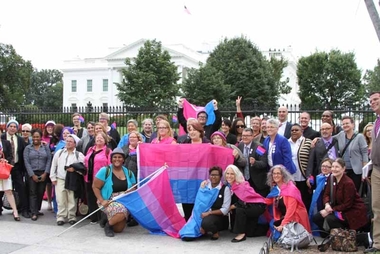Learn more about the 50 percent of the LGBT community who are bisexual

by Rob Howard
Associate Editor
This week is Bisexual Awareness Week. Most observers agree that, even in the LGBT community, there is not a lot of understanding of bisexuality, and bisexuals – even though they compose 50 percent of the LGBT community.
Bisexual Awareness week was co-founded by GLAAD. It seeks to accelerate acceptance of the bi+ community. #BiWeek draws attention to the public policy concerns, while also celebrating the resiliency of, the bisexual community.
Throughout #BiWeek, allies and bi+ people learn about the history, culture, community and current policy priorities of bi+ communities.
Here’s some information:
The most basic – What is a bisexual person?HRC says, “A bisexual person is someone who can be attracted to more than one gender, and studies show that as much as half of the lesbian, gay and bisexual population identify as bisexual. In other words, bisexual–– or bi –– people comprise the largest single group in the lesbian, gay, bisexual, transgender and queer (LGBTQ) community. HRC is working with other advocates to increase bi visibility and address the unique needs of the bisexual community.”
HRC also publishes FAQs about bisexuality. Here are some of them:
How many people are bisexual?According to the Williams Institute and the HRC Foundation's own research, studies suggest that about 50 percent of people who identify as either gay, lesbian, or bisexual, identify as bisexual. This makes the bisexual population the single largest group within the LGBTQ community.
Can a transgender person also be bisexual?Yes, and some are. Because sexual orientation refers to a person's sexual or romantic attraction and gender identity is about how people identify themselves along the spectrum of gender, transgender people can identify as lesbian, gay, straight, bisexual, or any other sexual orientation.
What is biphobia?Biphobia is prejudice, fear, or hatred directed toward bisexual people. It can include making jokes or comments based on myths and stereotypes that seek to undermind the legitimacy of bisexual identity, like "bisexuality is a phase" or "bi people are greedy." Biphobia occurs both within and outside of the LGBTQ community.
What are some of the unique issues that bisexual people face?In addition to biphobia, bisexual people are often excluded or rendered invisible in LGBTQ spaces and conversations about LGBTQ issues. Bisexual people are sometimes assumed to be straight or gay based on the gender of the person they are currently dating.
Because of biphobia and bi erasure, bisexual people suffer significantly higher rates of depression and anxiety, domestic violence, sexual assault, and poverty than lesbians, gay men, or straight cisgender (non-transgender) people. Bisexuals also face major health disparities and poor healthcare outcomes from a lack of adequate preventative care. The HRC Foundation’s study of bisexual youth suggests that biphobia and sexual harassment start affecting bisexuals at a young age.
There are plenty of resources available to learn more about bisexuals and bisexuality.
One of the main groups advocating for bisexuals is BI Net USA. Visit their website at www.binetusa.org/.
The Human Rights Campaign has an extensive section on their website called Explore: Bisexual. It has a lot of information, including a section of Coming Out as Bisexual. Visit www.hrc.org/explore/topic/bisexual.
GLAAD also has information about bisexuals, including a media guide for reporting on bisexual issues. All available at www.glaad.org/bisexual.
Copyright 2016 The Gayly – September 22, 2016 @ 4:30 p.m.





